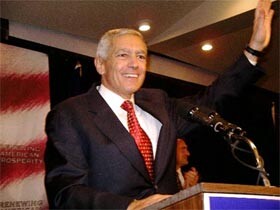The Electronic Intifada 10 November 2003

Partners for Peace encouraged CNN to check its facts on the Separation Barrier. As a result, CNN increased the projected length of the barrier from 217 miles to 429. Likewise, CNN’s citation of the cost grew from US$200 million to US$1.5 billion — overnight.
For months CNN has misrepresented the facts of where Israel’s apartheid barrier will run. Repeated interventions by Partners for Peace have only brought marginal improvements. Efforts on November 5-6, however, brought significant change.
On November 5, CNN wrote:
“Israel has already constructed 93 miles (150 km) of the barrier in the north. When finished the barrier will stretch 217 miles (350 km) at an estimated cost of $200 million.”
This simply is not the case. Numerous sources have put the anticipated length of the barrier at 400 miles and Molly Moore in the Washington Post of October 31 — http://www.washingtonpost.com/wp-dyn/articles/A44374-2003Oct30_2.html — cited the Finance Ministry as saying the final cost was expected to be $2.3 billion. Both figures are significantly higher than the totals cited by CNN.
Efforts by Partners for Peace brought the following change from CNN on November 6:
“According to Defense Ministry spokeswoman Rachel Niedak-Ashkenazi, the planned fence route, which has been approved by the government, will be 690 kilometers (429 miles) long. Cost is estimated at $1.5 billion.”

The corrected article on November 7th.
A New York Times map of November 12, provided by the United Nations Office for the Coordination of Humanitarian Affairs, indicates, however, that the barrier will reach more than 400 miles before even traversing the Jordan Valley. See http://www.nytimes.com/2003/11/12/international/middleeast/12MIDE.html (map at right). The extraordinary depiction highlights the manner in which the barrier relentlessly doubles back on itself as it wends its way across the western portion of the West Bank (as well as the northern and southern reaches). Further information can be found at: http://www.globes.co.il/serveen/globes/docview_archive.asp?did=736547. This article makes clear that Israel does intend at some future juncture to construct an eastern barrier. Readers will note that the total anticipated cost of both the western and eastern barriers is NIS 15 billion (well over $3 billion).
The announced total distance should galvanize the State Department into action. Prime Minister Ariel Sharon clearly intends to reduce Palestinians to an apartheid-like existence in walled or fenced-off bantustans. The State Department has an immediate responsibility to lop $1.5 billion or more from the loan guarantees for the barrier alone (and an additional amount for settlement activity), while making a clear and powerful statement that the barrier inside the West Bank is antithetical to any meaningful peace agreement.
In a frightening turn of timing, General Wesley Clark wrote in the November 7 issue of The Forward that “the fence is not a barrier to the peace process.” In fact, it is a very real threat both to any peace process and to the possibility of a viable Palestinian state. In full, the presidential candidate states:
“Currently, Israel is building a security fence — not because it wants to, but because terrorism has forced its hand. The fence is not a barrier to the peace process. No country can negotiate if the other side believes it has no alternatives. The fence will help contain the terrorist onslaught. It will warn other parties in the Middle East that they need to start negotiating — now. But it is not a sustainable substitute for peace.”

Wesley Clark

An erroneous BBC graphic.
Meanwhile, across the Atlantic, the standards at the BBC continue to plummet. For weeks the BBC has ignored concerns from Partners for Peace that the news network is understating the length of the barrier by claiming it will be 245 km (150 miles) in length. Once again, this simply is not the case. Perhaps the figure will be the case after the next interim segment of the barrier is completed, but the BBC has a responsibility to indicate in a clear manner the difference between the length of the barrier when partially completed and the anticipated final length. Right now those who get their news from the BBC are left with the impression of a segregation barrier considerably shorter in distance than even Israeli officials are stating.
Update
Within two days of publication of this EI article, the BBC brought its barrier information up to date (see http://news.bbc.co.uk/2/hi/middle_east/3260855.stm and view the link on the bottom graphic). The cost per kilometer is still low at $1.6 million per kilometer, but the total projected length of the barrier is now far more accurate. It is, however, worth noting that if the barrier is expected to reach more than 400 miles before its eastern portion is even constructed then additional scores of miles will have to be added.
Michael F. Brown is the Executive Director of Partners for Peace. Jamie Brooks of Vermonters for a Just Peace in Palestine/Israel contributed some research to this article.





